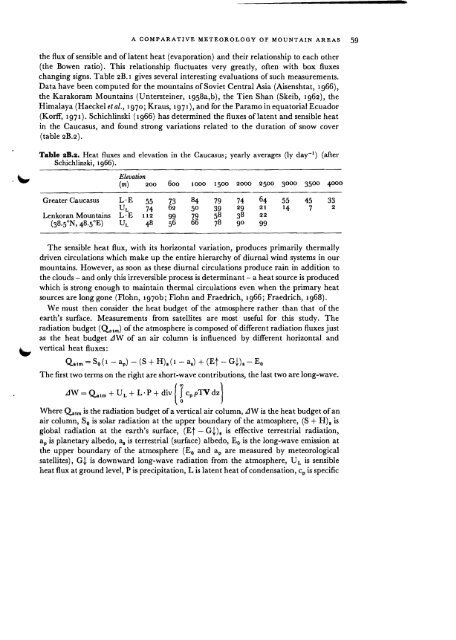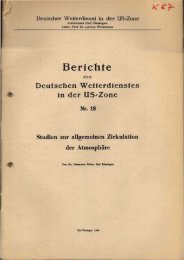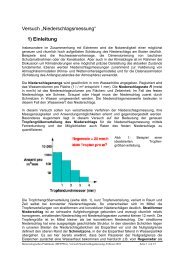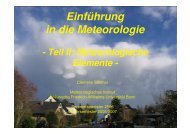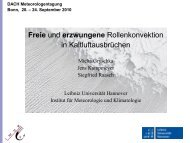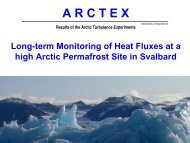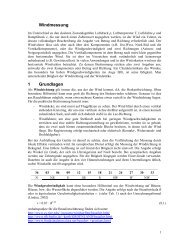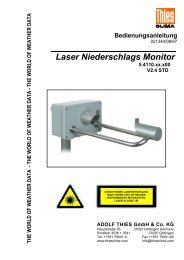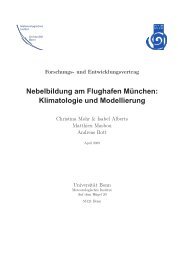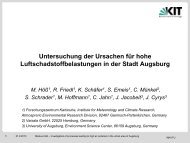Contribution to a comparative meteorology of n10untain areas
Contribution to a comparative meteorology of n10untain areas
Contribution to a comparative meteorology of n10untain areas
You also want an ePaper? Increase the reach of your titles
YUMPU automatically turns print PDFs into web optimized ePapers that Google loves.
A COMPARATIVE METEOROLOGY OF MOUNTAIN AREAS 59the flux <strong>of</strong> sensible and <strong>of</strong>latent heat (evaporation) and their relationship <strong>to</strong> each other (the Bowen ratio). This relationship fluctuates very greatly, <strong>of</strong>ten with box fluxes changing signs. Table 2B.l gives several interesting evaluations <strong>of</strong>such measurements. Data have been computed for the mountains <strong>of</strong> Soviet Central Asia (Aisenshtat, 1966), the Karakoram Mountains (Untersteiner, 1958a,b), the Tien Shan (Skeib, 1962), the Himalaya (Haeckel et ai., 1970; Kraus, 1971), and for the Paramo in equa<strong>to</strong>rial Ecuador (Korff, 1971). Schichlinski (1966) has determined the fluxes <strong>of</strong>latent and sensible heat in the Caucasus, and found strong variations related <strong>to</strong> the duration <strong>of</strong> snow cover (table 2B.2). .\.,Table 2B.2. Heat fluxes and elevation in the Caucasus; yearly averages (ly day-i) (afterSchichlinski, 1966).Elevation(m) 200 600 1000 15°0 2000 2500 3 000 3500 4000 Greater Caucasus L·E 55 73 84 79 74 64 55 45 33 U L 74 62 50 39 29 21 14 7 2 Lenkoran Mountains L·E 112 99 79 58 38 22 (38·5°N,48·5°E) U L 4B 56 66 78 90 99 The sensible heat flux, with its horizontal variation, produces primarily thermallydriven circulations which make up the entire hierarchy <strong>of</strong> diurnal wind systems in ourmountains. However, as soon as these diurnal circulations produce rain in addition <strong>to</strong>the clouds - and only this irreversible process is determinant - a heat source is producedwhich is strong enough <strong>to</strong> maintain thermal circulations even when the primary heatsources are long gone (Flohn, 197ob; Flohn and Fraedrich, 1966; Fraedrich, 1968).We must then consider the heat budget <strong>of</strong> the atmosphere rather than that <strong>of</strong> theearth's surface. Measurements from satellites are most useful for this study. Theradiation budget (Qatm) <strong>of</strong> the atmosphere is composed <strong>of</strong> different radiation fluxes justas the heat budget LlW <strong>of</strong> an air column is influenced by different horizontal andvertical heat fluxes:Q.tmSo(l-a p )-(S+H)s(l-as)+(Et- Gt). EoThe first two terms on the right are short-wave contributions, the last two are long-wave.LlW = Q.lm + U L+ L·P + div (! cppTV dZ)Where Q.tm is the radiation budget <strong>of</strong>a vertical air column, LlW is the heat budget <strong>of</strong>anair column, So is solar radiation at the upper boundary <strong>of</strong> the atmosphere, (S + H)s isglobal radiation at the earth's surface, (Et - Gt)s is effective terrestrial radiation,apis planetary albedo, a. is terrestrial (surface) albedo, Eo is the long-wave emission atthe upper boundary <strong>of</strong> the atmosphere (Eo and a p are measured by meteorologicalsatellites), Gt is downward long-wave radiation from the atmosphere, U L is sensibleheat flux at ground level, P is precipitation, L is latent heat <strong>of</strong>condensation, c p is specific


